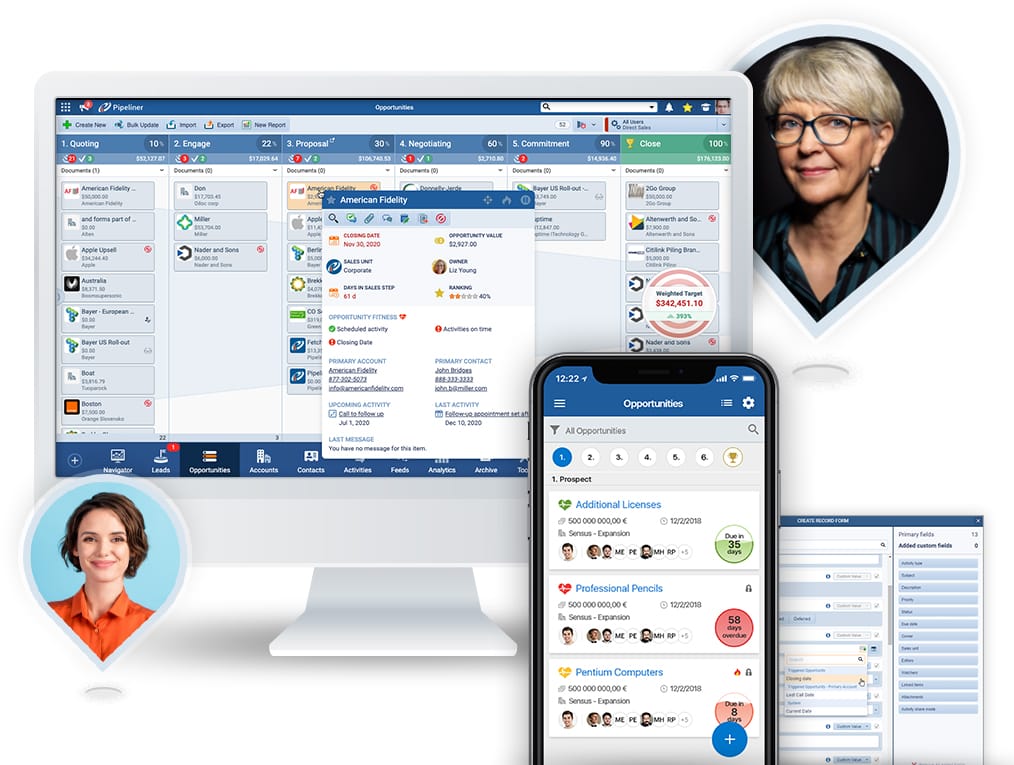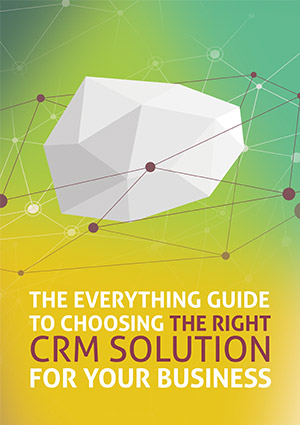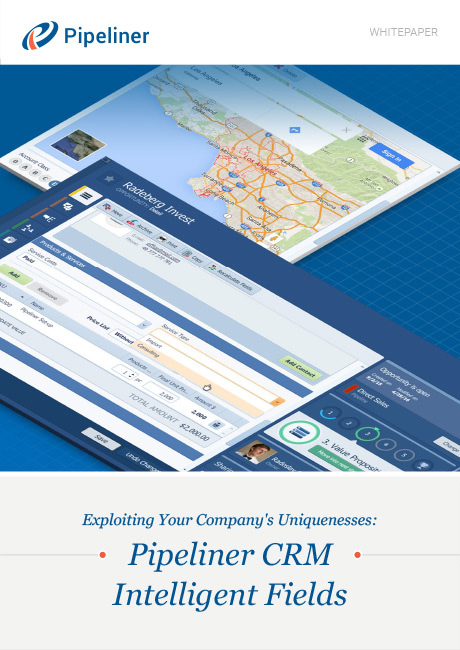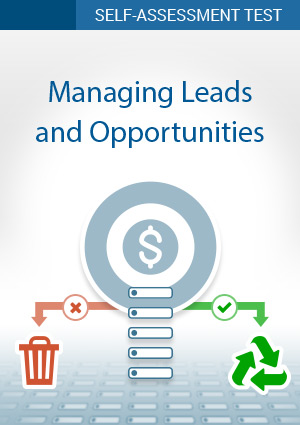PipelinePipeline Sales pipelineis a visual representation of the stage prospects are in the sales process. Management
What is CRM
- What is CRM?
- Customer Relationship Management Software
- Account Management Software
- Contact Management Software
- Sales Lead Management
- Opportunity Management
- Sales Pipeline Management
- Customer Relationship Mapping
- Sales Enablement Tools
- Sales Management Software
- Sales Process
- Sales Reporting
- Task Management
- Custom Fields
- Team Collaboration
- KPIs for Sales & Leading and Lagging Indicators
- CRM Past Failures?
Understanding Sales PipelineSales Pipeline Sales Pipeline is a type of visualization showing the status of each sales prospect in the customer life cycle or sales process. Management: What is the Sales Pipeline?
In order to understand sales pipeline management, you first must understand what a sales pipeline is. A sales pipeline is a four-stage visual representation of the sales processSales Process Sales Process is a series of strategic steps or a set of activities aimed at driving sales growth through the alignment of personnel, market insight, methodologies, relevant business units, and technology.. An effective sales pipeline will assist sales representatives and teams in managing the often complex processes required to close deals. A sales pipeline indicates how many deals a salesperson is expected to close on a weekly, monthly, or yearly basis, as well as how close a representative is to meeting their sales quotaQuota Quota is a predefined benchmark indicating the amount of sales a selling unit such as a sales rep or a regional sales team should achieve within a given period, often used as a measure of success, performance and eligibility for commissions and other rewards..
Sales pipelines have been around for a long time, but mastering them can be difficult. To be effective, sales leaders must have a combination of real-world experience, detailed design, and a willingness to change and adapt.

Sales Pipeline vs. Sales FunnelSales Funnel Sales Funnel is a visualization of the sales process that defines the stages through which prospective customers go through as they are led by sales professionals towards a purchasing decision.: Understanding the Difference
Before we proceed, it’s essential to clarify a common misconception: the distinction between a sales pipeline and a sales funnel. While these terms are often used interchangeably, they refer to different concepts in sales.
Think of the sales pipeline as an internal tool for sales teams—a structured visual that shows the progress of individual deals through specific stages, from initial contact to closing. It helps reps see where each opportunity stands, forecast revenueRevenue Revenue is the amount of money a business generates during a specific period such as a year or a quarter; also called sales., and manage daily sales activities.
On the other hand, the sales funnel represents the entire customerCustomer Customer is an individual or an organization that purchases a product or signs up for a service offered by a business. journey from the buyerBuyer A buyer is an individual or organizational entity that purchases a product or subscribes to a service.’s view. It captures the broad flow of prospects as they move from awareness, through consideration, and—at the narrow end—toward making a purchase. The sales funnel focuses on understanding conversionConversion Conversion is the process of turning a target consumer into a paying customer; or more generally, the point at which a user performs a specific action favorable to a marketer or a seller. rates and how prospects “filter down” at each stage.
The pipeline is an integral part of your sales process, focusing on the actions you take for each deal.
The funnel maps the customer’s path, helping you identify where to boost engagementEngagement Engagement is the state or process of keeping a specific class of audience (employees, management, customers, etc.) interested about a company or brand and invested in its success because of its perceived relevance and benefits to the audience. and prevent drop-offs.
Understanding this difference enables sales teams to analyze both the quantity and quality of their opportunities, keeping deals progressing smoothly while also enhancing the customer journey that leads to becoming a buyer.
What is Sales Pipeline management?
Sales pipeline management is at the crux of everything we do in the sales industry. Mastering the sales pipeline is a critical step in increasing revenue because it allows sales representatives to stay organized and focused on selling.
In other words, the tracking and management of every sales opportunity from its inception to the successful completion of a revenue-generating contract.
A sales pipeline is a method of selling that is based on the underlying principles of the sales process. It describes the various sales stages that salespeople go through, starting with the initial contact with a potential clientClient A client is an entity who pays another entity for products purchased or services rendered. Also called a customer. or prospect and continuing with the qualification of that client or prospect into a leadLead Lead refers to a prospect or potential customer (who can be an individual or organization) that exhibits interest in your service or product; or any additional information about such entity. and finally further validating that lead into a sales opportunity, followed through the various stages of a company until closed.
Experience Pipeliner CRM Now
Best Practices for Effective Sales Pipeline Management
Mastering sales pipeline management isn’t just a matter of tracking deals as they move from one stage to the next—it’s about establishing habits and systems that give your team a clear view of where they stand, what’s working, and where roadblocks might be holding things up. Here’s how you can ensure your pipeline remains robust, accurate, and primed for success:
- Keep Your DataData Data is a set of quantitative and qualitative facts that can be used as reference or inputs for computations, analyses, descriptions, predictions, reasoning and planning. Spotless
Your CRM is only as powerful as the data it holds. Take the time to verify, update, and purge your pipeline records routinely. Outdated contacts or piecemeal information can result in missed opportunities or casting a less-than-professional light. Make a habit of cross-referencing details through reliable sources—think LinkedInLinkedIn LinkedIn is a social network for the business community. or company websites—to keep your outreach sharp and relevant.
- For example, rather than sending emails into the void, regularly confirm key fields such as job titles and contact information. This proactive approach enables your representatives to connect with the right people at the right time.
- Standardize Your Sales Stages
A well-defined sales methodology forms the backbone of pipeline consistency. Establish clear actions and exit criteria for each stage of your process, ensuring every salesperson speaks the same language and follows the same playbook. This consistency means fewer surprises and better forecastingForecasting Forecasting is a prediction or calculation of a trend or event likely to occur in the future based on qualitative, quantitative and historical data as well as emergent but relevant factors..
- Hint: Comprehensive sales enablementSales Enablement Sales Enablement is a strategic process that provides a company’s sales professionals with tools, technology, training and other resources that improve their performance at customer engagement and at generating value for all stakeholders in the sales process. training goes a long way toward bringing everyone onto the same page, reducing confusion, and focusing team energy on qualified opportunities.
- Foster Transparency Across Roles
Don’t let your pipeline become a black box. Shared dashboards and real-time reporting enable not only the sales team but also marketingMarketing Marketing is the field, set of actions, or practice of making a product or service desirable to a target consumer segment, with the ultimate aim of effecting a purchase. and leadership to monitor progress and identify bottlenecks before deals stall. Transparency enables quicker interventions and more effective collective strategy adjustments.
- Tip: Review conversion rates, deal values, and close timelines as a team to ensure consistency and effectiveness. Identifying trends early prevents minor issues from snowballing.
- Conduct Regular Pipeline Reviews
Make time for team discussions where every active deal is scrutinized. These sessions are invaluable for surfacing obstacles—be they pricing hang-ups, competitor moves, or customer indecision—and brainstorming solutions. Data-driven reviews, in tandem with feedback from reps on the ground, help to chart next steps and maintain momentum.
- Pro tip: Compare current deal flow to historical patterns to set benchmarks and spot anomalies quickly.
- Embrace Automation to Scale Efficiency
Leverage your CRM’s automation features to reduce tedious manual work and enable reps to focus on selling. Automate data entry, lead scoringLead Scoring Lead Scoring is the process of assigning a relative value to each lead based on different criteria, with the aim of ranking leads in terms of engagement priority., and follow-up reminders so nothing slips through the cracks. With the right triggersTriggers Triggers are a set of signals or occurrences that meet certain criteria to be considered an opportunity to make a sale.—a download, a webinar attendance, or a demo request—your system can alert the team the moment a lead deserves attention.
- Implementation idea: Set up point systems to flag high-interest prospects and let the CRM automatically surface these priority leads.
Adopting these best practices creates a sales pipeline that’s clean, consistent, visible, and proactive—building the foundation for predictable growth and a high-performing team.
Common Sales Pipeline Management Challenges—and How to Tackle Them
Even with a well-mapped sales pipeline, navigating the path from first contact to closed deal isn’t always smooth sailing. Sales professionals frequently encounter a few familiar roadblocks that can hinder progress and impact results. Let’s explore some of the most common challenges, along with actionable strategies to leave those hurdles in the dust:
1. Misalignment Between Sales and Marketing
When sales and marketing teams don’t work in harmony, the fallout can result in missed opportunities, duplicated efforts, and inconsistent messages to potential clients.
How to overcome it:
- Foster open communication and set up regular touchpoints between teams.
- Develop shared goals and key performance indicators to ensure everyone is working towards the same objectives.
- Leverage CRM platforms with cross-functional dashboards to unite both teams’ efforts and track progress transparently.
- Example in action: Marketing designs a campaign targeting manufacturing clients. By sharing campaign details with sales representatives, they can tailor their pitch, resulting in a warmer reception and quicker conversions.
2. Deals That Stall Mid-Process
Every salesperson knows the pain of watching promising deals grind to a halt—often due to indecision, objections, or competitive noise.
How to overcome it:
- Schedule regular pipeline reviews to identify deals that have lingered too long in a single stage.
- Create an escalation protocol for stalled opportunities, inviting sales leadership or specialist colleagues to help remove obstacles.
- Always keep lines of communication open—sometimes, a gentle nudge or reassessment of prospect needs is all it takes.
3. Inaccurate Sales Forecasting
If your forecast is based on guesswork instead of data, you’re sailing in foggy waters. Inaccurate forecasts can result in over- or underestimating revenue, disrupting everything from cash flow to staffing.
How to overcome it:
- Make full use of your CRM’s forecasting and analyticsAnalytics Analytics is the active study of different types of data with the aim of discovering meaningful patterns and translating these into insight (such as historical analyses and forecasts), or action (such as those intended to improve business performance). capabilities. Leading platforms, such as Insightly or Pipedrive, offer forecasting tools that factor in pipeline stage, deal value, and historical win rates.
- Regularly update your projections with real-time data, including market shifts and seasonal trends, for more accurate results.
4. Sales Cycles That Drag On
Long sales cycles are tough—they tie up valuable time and resources, challenge your team’s patience, and increase the risk of losing a deal.
How to overcome it:
- Qualify leads rigorously from the start to ensure your time is spent on viable opportunities.
- Address potential roadblocks early by being transparent with prospects and setting clear expectations.
- Use automated workflows within your CRM to keep things moving—and everyone informed—at every step.
- Pro tip: For complex, high-value deals (such as B2BB2B B2B is an acronym for Business-to-Business, a model for selling, relationship-building, or engagement. SaaSSaaS SaaS is an acronym for Software as a Service. solutions), address technical or integration questions before they stall momentum.
Tackling these challenges head-on transforms pipeline management from a daily struggle to a scalable, repeatable advantage—setting you and your team up for both quick wins and long-term gains.
How Can You Improve Your Sales Pipeline Management Process?
Optimizing your sales pipeline management isn’t just about having a process in place—it’s about constantly refining it to keep your team at the top of their game. Here are a few approaches to further enhance your pipeline management:
- Implement Lead Scoring Methods: Not all leads are created equal. Establish a clear lead scoring system based on criteria such as job title, company size, level of engagement, and fit with your ideal customer profile. This helps your team focus energy where it matters most, ensuring that top-tier opportunities don’t slip through the cracks.
- Hold Regular Pipeline Reviews: Set aside time to review your pipeline with your team regularly. These collaborative sessions can uncover what’s working, expose bottlenecks, and highlight opportunities for improvement. Encourage open communication—your frontline salespeople often have crucial insights gathered from real-world interactions.
- Refine Lead QualificationLead Qualification Lead Qualification is the process of determining whether a potential customer has the characteristics of your company’s ideal client (such as sufficient purchasing ability and a higher likelihood of buying your product). Standards: Time is valuable. Strengthen your qualification criteria by defining precisely what makes a lead worth pursuing—think industry, decision-making power, budget, and specific needs. The more precise your standards, the less time your team will waste on leads that are unlikely to convert.
By consistently evaluating and improving these elements, you’ll build a more resilient and effective sales engine. Making incremental adjustments informed by data and team feedback ensures that your sales process continues to evolve in tandem with shifting customer expectations and market dynamics.
Common Challenges in Sales Pipeline Management—and How to Overcome Them
While the concept of a sales pipeline is straightforward, consistently managing it presents numerous challenges. Many sales teams run into the following roadblocks—fortunately, there are practical solutions for each.
- Losing Track of Opportunities
Without apparent oversight, promising leads can slip through the cracks. This often happens when prospect data isn’t kept up-to-date or tasks and next steps aren’t clearly defined.
SolutionSolution Solution is a combination of ideas, strategies, processes, technologies and services that effectively helps an organization achieve its goals or hurdle its challenges.:
Commit to regular pipeline reviews—weekly or biweekly sessions to audit each deal’s status. Utilize visual tools like Kanban boards (available on platforms such as Trello or Monday.com) to track progress and set automated reminders for follow-up actions.
- Wasting Time on Unqualified Leads
It’s easy to get bogged down chasing prospects who, realistically, will never convert. This diverts resources and detracts attention from high-value opportunities.
Solution:
Establish a lead scoring system that objectively ranks prospects based on buying intentBuying Intent Buying Intent refers to the apparent likelihood of a person or organization of purchasing a product or service as inferred from behavior such as online browsing, media consumption, document downloads, event participation., fit, and engagement. CRM tools can automate lead scoring, ensuring your team stays focused on leads that are most likely to close.
- Communication Gaps Lead to Poor Customer Experiences
Disorganized pipelines can result in delayed responses, inconsistent messagingMessaging Messaging is the process of communicating your brand’s value proposition, the benefits you offer, and the perceived meaning of such communication among your target audience., or duplicate outreach—leaving prospects feeling undervalued.
Solution:
Standardize and document your sales process. Leverage shared calendars, notes, and email templates within your CRM to coordinate communication. Ensure everyone on the team understands the cadence and tone for each interaction.
- Lack of Insight Hinders Decision-Making
When you’re not capturing and tracking key metricsMetrics Metrics are quantities that are measured and used to:, sales forecasts become guesswork rather than informed predictions.
Solution:
Regularly analyze pipeline metrics—such as conversion rates at each stage and average deal velocity—using analytics dashboards in tools like InsightSquared or Pipedrive. These insights support more accurate forecasting and informed resource allocation.
- Team Motivation Suffers
A chaotic, cluttered pipeline can sap energy and motivation, as the path to winning deals becomes unclear.
Solution:
Break big goals into smaller, stage-based targets. Celebrate progress at each step, not just at closing. Encourage healthy competition using gamification platforms like Ambition to keep spirits high and maintain focus.
By addressing these challenges head-on and adopting intentional management strategies, sales professionals can transform a messy pipeline into a powerful engine for growth that keeps deals—and momentum—moving forward.
How Standardizing Your Sales Process Strengthens Your Sales Team
When each sales rep creates their unique way of working leads, things can quickly spiral into confusion—making results unpredictable and collaboration tricky. That’s where a standardized sales process comes in handy. By establishing clear stages, consistent terminology, and defined actions for each step, everyone on the team speaks the same language and pulls in the same direction.
Standardization isn’t just about documentation, though. With everyone trained on the same proven process (think onboardingOnboarding Onboarding is the process or act of introducing a new customer to your product or service; or integrating a newly hired employee into your workforce or team. programs from organizations like HubSpot Academy or the Sandler Sales Institute), your team operates like a well-oiled machine. Reps know precisely what’s expected at every stage, so you can spot bottlenecks, provide targeted coaching, and maintain a high level of accountability.
For example, consider a mid-marketMid-Market Mid-Market is a classification of business organizations in terms of scale (revenue, number of employees, etc.), occupying the segment between the small companies and large multinational enterprises serving the same market. company that rolled out a new lead qualification process across its sales department. By providing everyone with a checklist for early-stage qualification—with specific criteria and follow-up actions—they reduced wasted time chasing leads that were unlikely to close. The result? More focus on high-potential opportunities and a smoother path from prospect to customer.
In short, a standardized process brings clarity, consistency, and continuous improvement—providing your sales team with the structure they need to deliver repeatable, predictable results.
The Ripple Effects of Sales and Marketing Misalignment
Misalignment between sales and marketing can quietly derail even the most promising sales pipelines. When these two teams operate in silos, the result is often duplicated efforts, unclear messaging, and missed opportunities—all of which make it harder for sales representatives to guide prospects through the pipeline efficiently.
For example, suppose marketing runs a campaign without syncing up with sales. In that case, teams might end up pursuing the same leads with different strategies, leading to confusion both internally and for the prospect. This disconnect not only wastes resources but also blurs the customer journey, making it harder to build trust and close deals.
Bridging the Gap: Unifying Goals and Communication
To keep your sales pipeline running smoothly, it’s essential that both sales and marketing move in harmony. Here are some practical steps to achieve alignment:
- Set Shared Objectives: Develop common goals and agreed-upon performance metrics—such as the number of qualified leads generated or opportunities created—to ensure both teams are rowing in the same direction.
- Regular Collaboration: Encourage ongoing dialogue through joint meetings, planning sessions, or workshops. This ensures everyone understands campaign details, target audiences, and messaging.
- Leverage Shared Tools: Utilize CRM systems with cross-departmental dashboards, enabling both teams to track pipeline progress and adjust strategies in real-time.
Consider this: When marketing launches a campaign targeting a specific sector, sharing those insights with sales representatives allows them to tailor their outreach effectively, resulting in more personalized conversations and higher conversion rates.
By fostering open communication and unified goals, organizations can eliminate bottlenecks in the pipeline and create a seamless experience—for both team members and customers.
Why is a Sales Pipeline Important?
A pipeline is a business and marketing tool that should not be overlooked or taken for granted. Here are some of the most important reasons for having a sales pipeline, foreshadowing how crucial sales pipeline management is.
1. It displays the status and accountAccount Account refers to a record of primary and background information about an individual or corporate customer, including contact data, preferred services, and transactions with your company. of sales representatives.
Sales representatives are frequently on the front lines of a company’s operations. They are required to reach your target market as well as new prospective clients. As a result, you must be able to monitor the status and accounts of sales representatives.
2. It demonstrates the worth and quality of success.
Not all business transactions generate revenue for the company. Some business transactions are dormant for an extended period of time. The sales pipeline can also detect this. What matters in business is the quantity or number of closed deals and the quality of each contract at every stage of the process.
3. It enables the company to forecast potential revenue.
It is critical for a business to have a tool for potential forecasting revenue. A sales pipeline will allow you to do the same thing by highlighting areas in sales that are nearing quota or are still far behind as weak points.
Forecasting potential revenue is critical because it can help you determine if you are still on track to meet financial targets or if you have fallen far behind and need to revise your marketing strategies.
4. It provides you with a clear report on financial metrics.
Running a business requires you to rely heavily on numbers to double-check and verify your position in every lead client and opportunity. Financial metrics are critical for determining whether goals are being met, whether profits will be available soon, or if the company is having difficulty closing deals that translate to positive business opportunities.
Here are some critical business metrics that your sales pipeline can demonstrate:
- The number of transactions that a company can complete through its representatives.
- The size of the deals that sales representatives can close.
- The percentage of transactions that are successfully converted into profit-generating opportunities for the company.
- The amount of time or period required to close a profitable deal.
5. It makes scheduling follow-up appointments easier.
Follow-ups at each stage of the sales process are one way to boost productivity in a business. Because you are more aware of which areas of the pipeline require the most pushing, using a pipeline makes it easier to schedule and conduct regular follow-ups. More importantly, sales pipeline software includes a mechanism for scheduling meetings and follow-ups with any member of your sales team, as well as with the client.

Sales Pipeline Stages
Sales pipelines vary in length, but they all have seven stages. As a result, you can customize these seven sales steps to meet your needs to create a simple pipeline representation. Furthermore, your niche and the lead generationLead Generation Lead Generation is a set of activities aimed at generating interest around a product or service through methods such as 1. content marketing (blogging, podcasts, free downloads); 2. advertising (PPC, banner ads, Yellow Pages, sponsoring an event); 3. referrals (recommendations from existing customers and other people); 4. outbound marketing (cold email, cold calling), and 5. partnerships (joint ventures, affiliate marketing). and deal conversion strategies you employ will determine the order of the stages you include. This allows for optimal sales pipeline management.
#1
Lead Generation
The first step is lead generation, which is the process of identifying and nurturing inboundInbound Inbound refers to interest (could be sales or marketing driven) that comes in – e.g. cold emails to you, submitted forms on your website, press inquiries, etc. leads generated by your sales campaigns and activities at this stage of the pipeline.
#2
Lead NurturingLead Nurturing Lead Nurturing refers to the process of engaging and building long-term relationships with prospective customers through different marketing techniques that develop their preference for your product and services.
Lead nurturing is the next stage of the sales pipeline. Most businesses understand that not every customer is a good fit for their goods or services. The goal here is to save time and resources by performing a sales pipeline analysis to eliminate bad leads before speaking with them or creating a targeted campaign.
#3
Meeting
Following that, arrange for a demo or meeting to introduce potential buyers to your offerings and solution. Initiating contact with a potential customer is meant to stimulate their interest in the good or service being given and to learn enough about them to decide if they’re a good fit.
#4
Proposal
Make your case by summarizing how your company can assist in meeting the needs of the potential customer. Keep your proposal as brief as possible while remaining thorough. Concentrate on the outcomes and objectives, and ensure that the number of deliverables you provide corresponds to the price. Remember to state your competitive advantages at this stage to help differentiate your proposal from other vendors your customer may meet.
#5
NegotiationNegotiation Negotiation is a strategic dialogue, discussion, or bargaining process between two or more parties with the goal of reaching a mutually acceptable agreement.
To reach an agreement on a mutually beneficial partnership, discuss expanding or contracting the scope of work, adjusting pricing, and managing expectations.
#6
Close the Deal
Congratulations, you’ve reached the most critical stage of the sales pipeline. Prospects make a purchase or sign a contract at this point. You will not make sales unless you master the art of closing the deal, no matter how good your productProduct Product refers to anything (an idea, item, service, process or information) that meets a need or a desire and is offered to a market, usually but not always at a price. or service is. There are a few key points to remember at this stage.
#7
Follow-Up
The goal of the final sales pipeline stage is to keep your company and your salesperson in the customer’s mind so that when they’re ready to buy again, they think of you first.



